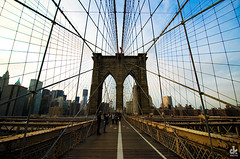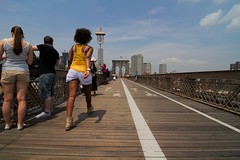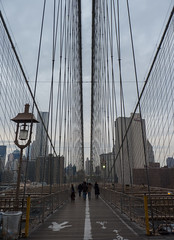Brooklyn Bridge
The Brooklyn Bridge is a hybrid cable-stayed/suspension bridge in New York City, spanning the East River between the boroughs of Manhattan and Brooklyn. Opened on May 24, 1883, the Brooklyn Bridge was the first fixed crossing of the East River. It was also the longest suspension bridge in the world at the time of its opening, with a main span of and a deck above mean high water. The span was originally called the New York and Brooklyn Bridge or the East River Bridge but was officially renamed the Brooklyn Bridge in 1915.
Proposals for a bridge connecting Manhattan and Brooklyn were first made in the early 19th century, which eventually led to the construction of the current span, designed by John A. Roebling. The project's chief engineer, his son Washington Roebling, contributed further design work, assisted by the latter's wife, Emily Warren Roebling. Construction started in 1870, with the Tammany Hall-controlled New York Bridge Company overseeing construction, although numerous controversies and the novelty of the design prolonged the project over thirteen years. Since opening, the Brooklyn Bridge has undergone several reconfigurations, having carried horse-drawn vehicles and elevated railway lines until 1950. To alleviate increasing traffic flows, additional bridges and tunnels were built across the East River. Following gradual deterioration, the Brooklyn Bridge has been renovated several times, including in the 1950s, 1980s, and 2010s.
The Brooklyn Bridge is the southernmost of the four toll-free vehicular bridges connecting Manhattan Island and Long Island, with the Manhattan Bridge, the Williamsburg Bridge, and the Queensboro Bridge to the north. Only passenger vehicles and pedestrian and bicycle traffic are permitted. A major tourist attraction since its opening, the Brooklyn Bridge has become an icon of New York City. Over the years, the bridge has been used as the location of various stunts and performances, as well as several crimes and attacks. The Brooklyn Bridge has been designated a National Historic Landmark, a New York City landmark, and a National Historic Civil Engineering Landmark.
Description
The Brooklyn Bridge, an early example of a steel-wire suspension bridge, uses a hybrid cable-stayed/suspension bridge design, with both vertical and diagonal suspender cables. Its stone towers are neo-Gothic, with characteristic pointed arches. The New York City Department of Transportation (NYCDOT), which maintains the bridge, says that its original paint scheme was "Brooklyn Bridge Tan" and "Silver", although a writer for The New York Post states that it was originally entirely "Rawlins Red".
Deck
To provide sufficient clearance for shipping in the East River, the Brooklyn Bridge incorporates long approach viaducts on either end to raise it from low ground on both shores. Including approaches, the Brooklyn Bridge is a total of long when measured between the curbs at Park Row in Manhattan and Sands Street in Brooklyn. A separate measurement of is sometimes given; this is the distance from the curb at Centre Street in Manhattan.
Suspension span
The main span between the two suspension towers is long and wide. The bridge "elongates and contracts between the extremes of temperature from 14 to 16 inches". Navigational clearance is above mean high water (MHW). A 1909 Engineering Magazine article said that, at the center of the span, the height above MHW could fluctuate by more than due to temperature and traffic loads, while more rigid spans had a lower maximum deflection.
The side spans, between each suspension tower and each side's suspension anchorages, are long. At the time of construction, engineers had not yet discovered the aerodynamics of bridge construction, and bridge designs were not tested in wind tunnels. It was coincidental that the open truss structure supporting the deck is, by its nature, subject to fewer aerodynamic problems. This is because John Roebling designed the Brooklyn Bridge's truss system to be six to eight times as strong as he thought it needed to be. However, due to a supplier's fraudulent substitution of inferior-quality cable in the initial construction, the bridge was reappraised at the time as being only four times as strong as necessary.
The main span and side spans are supported by a structure containing six trusses running parallel to the roadway, each of which is deep. The trusses allow the Brooklyn Bridge to hold a total load of , a design consideration from when it originally carried heavier elevated trains. These trusses are held up by suspender ropes, which hang downward from each of the four main cables. Crossbeams run between the trusses at the top, and diagonal and vertical stiffening beams run on the outside and inside of each roadway.
An elevated pedestrian-only promenade runs in between the two roadways and above them. It typically runs below the level of the crossbeams, except at the areas surrounding each tower. Here, the promenade rises to just above the level of the crossbeams, connecting to a balcony that slightly overhangs the two roadways. The path is generally wide. The iron railings were produced by Janes & Kirtland, a Bronx iron foundry that also made the United States Capitol dome and the Bow Bridge in Central Park.
Approaches
Each of the side spans is reached by an approach ramp. The approach ramp from the Brooklyn side is shorter than the approach ramp from the Manhattan side. The approaches are supported by Renaissance-style arches made of masonry; the arch openings themselves were filled with brick walls, with small windows within. The approach ramp contains nine arch or iron-girder bridges across side streets in Manhattan and Brooklyn.
Underneath the Manhattan approach, a series of brick slopes or "banks" was developed into a skate park, the Brooklyn Banks, in the late 1980s. The park uses the approach's support pillars as obstacles. In the mid-2010s, the Brooklyn Banks were closed to the public because the area was being used as a storage site during the bridge's renovation. The skateboarding community has attempted to save the banks on multiple occasions; after the city destroyed the smaller banks in the 2000s, the city government agreed to keep the larger banks for skateboarding. When the NYCDOT removed the bricks from the banks in 2020, skateboarders started an online petition.
Cables
The Brooklyn Bridge contains four main cables, which descend from the tops of the suspension towers and help support the deck. Two are located to the outside of the bridge's roadways, while two are in the median of the roadways. Each main cable measures in diameter and contains 5,282 parallel, galvanized steel wires wrapped closely together in a cylindrical shape. These wires are bundled in 19 individual strands, with 278 wires to a strand. This was the first use of bundling in a suspension bridge and took several months for workers to tie together. Since the 2000s, the main cables have also supported a series of 24-watt LED lighting fixtures, referred to as "necklace lights" due to their shape.
In addition, 1,520 galvanized steel wire suspender cables hang downward from the main cables, and another 400 cable extend diagonally from the towers. These wires hold up the truss structure around the bridge deck.
Anchorages
Each side of the bridge contains an anchorage for the main cables. The anchorages are trapezoidal limestone structures located slightly inland of the shore, measuring at the base and at the top. Each anchorage weighs . The Manhattan anchorage rests on a foundation of bedrock while the Brooklyn anchorage rests on clay.
The anchorages both have four anchor plates, one for each of the main cables, which are located near ground level and parallel to the ground. The anchor plates measure , with a thickness of and weigh each. Each anchor plate is connected to the respective main cable by two sets of nine eyebars, each of which is about long and up to thick. The chains of eyebars curve downward from the cables toward the anchor plates, and the eyebars vary in size depending on their position.
The anchorages also contain numerous passageways and compartments. Starting in 1876, in order to fund the bridge's maintenance, the New York City government made the large vaults under the bridge's Manhattan anchorage available for rent, and they were in constant use during the early 20th century. The vaults were used to store wine, as they were kept at a consistent temperature due to a lack of air circulation. The Manhattan vault was called the "Blue Grotto" because of a shrine to the Virgin Mary next to an opening at the entrance. The vaults were closed for public use in the late 1910s and 1920s during World War I and Prohibition but were reopened thereafter. When New York magazine visited one of the cellars in 1978, it discovered a "fading inscription" on a wall reading: "Who loveth not wine, women and song, he remaineth a fool his whole life long." Leaks found within the vault's spaces necessitated repairs during the late 1980s and early 1990s. By the late 1990s, the chambers were being used to store maintenance equipment.
Towers
The bridge's two suspension towers are tall with a footprint of at the high water line. They are built of limestone, granite, and Rosendale cement. The limestone was quarried at the Clark Quarry in Essex County, New York. The granite blocks were quarried and shaped on Vinalhaven Island, Maine, under a contract with the Bodwell Granite Company, and delivered from Maine to New York by schooner. The Manhattan tower contains of masonry, while the Brooklyn tower has of masonry.
Each tower contains a pair of Gothic Revival pointed arches, through which the roadways run. The arch openings are tall and wide. The tops of the towers are located above the floor of each arch opening, while the floors of the openings are above mean water level, giving the towers a total height of above mean high water.
Caissons
The towers rest on underwa…
Looking for places related to Brooklyn Bridge?
Those are other destinations to find places related to Brooklyn Bridge:
- Bridge
- City Hall
- Heights Promenade
- Woolworth
- Montague Street Tun…
- 8 Spruce Street
- Tweed Courthouse
- Henry Street Settle…
- Bridge Cafe
- St. James' Roman Ca…
- 280 Broadway
- Confucius Plaza
- 70 Pine Street
- African Burial Grou…
- Thurgood Marshall U…
- Wavertree
- Broadway-Chambers
- Savings Bank
- Joralemon Street Tu…
- Surrogate's Court
- Times
- 1 Police Plaza
- Former Emigrant Ind…
- Lightship Ambrose
























